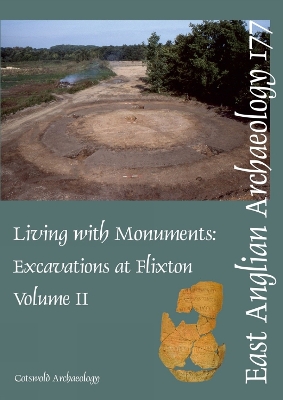Flixton Park Quarry lies in Suffolk on the south side of the Waveney Valley, on land that has been subject to aggregate extraction for many decades. Historically there was virtually no archaeological recording but the areas opened up since 1995 have all been subject to formal archaeological excavation under the auspices of archaeological planning guidance. The river terrace gravels of lowland Britain have historically provided a rich source for mineral extraction and aerial photography is often the only surviving record of large tracts of archaeological landscape that were destroyed before it became the legal responsibility of quarry operators to provide for archaeological work. Clearly, these multi-period landscapes are a finite and dwindling resource and it is essential to glean as much information as possible in advance of their development-led destruction. The significance of the Flixton Quarry site is not necessarily that the archaeology is unique, indeed aerial photographs often suggest a similar range of both funerary and settlement remains elsewhere, but the opportunities to excavate such large areas do not often occur.
The extensive prehistoric archaeology in this volume is dominated by monumental structures of the Early Neolithic (long barrow) and Early Bronze Age (ring-ditches). There were small clusters of unurned cremations of Middle Bronze Age date, a period which may also have seen the initiation of an extensive rectilinear field system. Settlement evidence from the Late Bronze Age included circular timber buildings and also four- or six-post square and rectangular structures that continued to be built into the Early Iron Age.
Significant Iron Age/Roman remains included three post-built structures probably representing large granaries (horrea), two pottery kilns and a multiple burial, the latter dated artefactually and by radiocarbon dating to the 1st century AD. Metalwork finds hint at military contact at this time.
The Early Anglo-Saxon period is represented at Flixton by two cemeteries (published as Volume I, Boulter and Walton Rogers 2012) and the settlement described here in Volume II. Structural evidence included post-built ‘halls’ and sunken-featured buildings. Artefactual dating suggests the occupation was broadly contemporary with the cemeteries and may have been directly associated.
Medieval features were limited to a rectangular enclosure with an entrance to the south that contained a small square enclosure with a central pit. Post-medieval deposits were dominated by ditched field boundaries many of which could be related directly to map evidence and to the farmland and the park surrounding Flixton Hall. WWI training trenches and latrine pits were also recorded.
- ISBN10 0993454585
- ISBN13 9780993454585
- Publish Date 1 June 2022
- Publish Status Active
- Publish Country GB
- Imprint Cotswold Archaeological Trust Ltd
- Format Paperback
- Pages 350
- Language English
